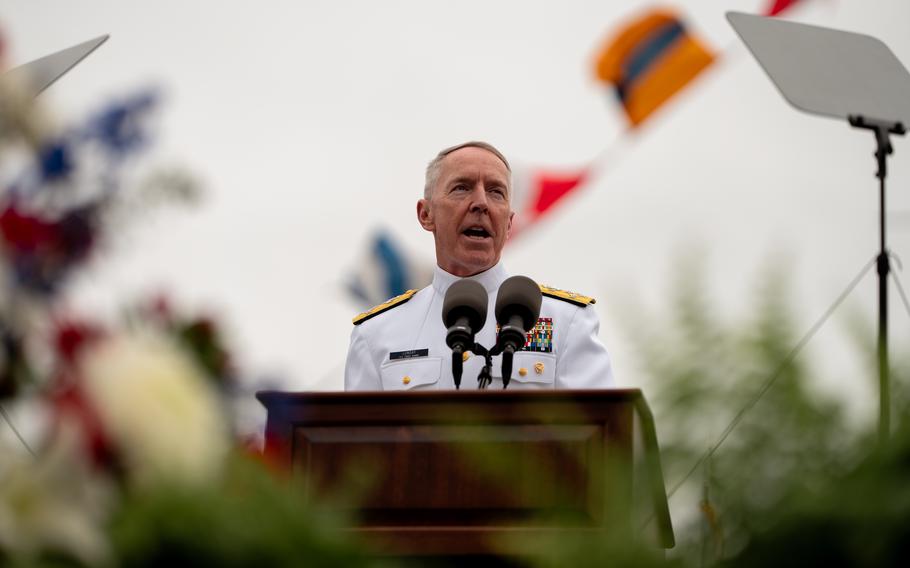
Department of Homeland Security Secretary Kristi Noem attends a ceremony at the U.S. Coast Guard Academy on May 21, 2025. (U.S. Coast Guard)
WASHINGTON — Kristi Noem, the secretary of the Department of Homeland Security, wants to slash the Coast Guard’s shore infrastructure budget by 90%, a move that some lawmakers said would push the service’s housing, facilities and piers into further disrepair.
“We must do better, because this is completely unacceptable,” Rep. Salud Carbajal, D-Calif., said Thursday during a hearing of the House Transportation and Infrastructure Committee.
Noem has proposed $21 million for fiscal 2026, which begins Oct. 1, to repair and maintain the Coast Guard’s shore infrastructure — a fraction of the more than $400 million that the service received in 2024. But a federal watchdog reported in March that the Coast Guard would need at least $7 billion to fix its shore infrastructure, which includes family housing and barracks, boat stations, piers, lighthouses, firing ranges, airfields, and Coast Guard shipyards.
Lawmakers have said they are considering a $1 billion increase in the Coast Guard’s overall budget — a jump from about $13.5 billion to $14.5 billion — as the Trump administration looks to pour funding into the service. But included in Noem’s proposal is a push to divert limited resources to “vanity projects,” Carbajal said.
“Budgets demonstrate values and priorities. What are this secretary’s priorities? Well, we know that she is planning to follow [President Donald Trump’s] lead in obtaining not one but two Gulf Stream jets to accommodate her travel at a cost of upward of $54 million. That is two and a half times the entire shoreside infrastructure budget for the Coast Guard,” Carbajal said.
Rep. Marilyn Strickland, D-Wash., echoed Carbajal.
“Slashing the Coast Guard shoreside infrastructure budget by 90% as mentioned earlier, while spending $50 million on a new jet for Secretary Noem is unserious and signals to the men and women of the Coast Guard that this administration does not value the mission or their wellbeing,” Strickland said.
The Coast Guard’s scope of shore infrastructure extends beyond piers and lighthouses. It includes housing units in remote locations for Coast Guard members and their families, training centers where new recruits learn and practice essential job skills, and command centers that direct missions such as search-and-rescue operations. These assets collectively represent a value of $24.5 billion, the service reported to the Government Accountability Office.
The Coast Guard is facing a backlog of at least $7 billion worth of maintenance and construction that has been put off for years, the GAO reported. That number was reported to the GAO by the Coast Guard and is likely higher, the watchdog said, because it does not consider inflation.
Many of the Coast Guard’s shore-based assets are beyond their expected service life and need revitalization or replacement. More than 230 of the service’s airfields need new lighting or repaving. About 30 of the Coast Guard shipyards need of a total of $451 million in repairs, and 1,046 piers need additional work. Nearly 840 dining facilities and upward of 900 family housing units also need repairs or replacing.
Carbajal said a Coast Guard member fell through a shower because moisture and mold rotted the floor. The incident shed light on eight housing units at Coast Guard Marine Safety Detachment Santa Barbara, Calif., that were riddled with mold.

Adm. Kevin Lunday, acting commandant of the U.S. Coast Guard, speaks during a ceremony at the U.S. Coast Guard Academy on May 21, 2025. (U.S. Coast Guard)
Adm. Kevin Lunday testified at the hearing that the issue has been resolved. Lunday, who was appointed the acting commandant of the Coast Guard, was recently nominated for the position permanently. He is awaiting a Senate confirmation hearing.
“None of our members should live in housing units that have mold or other conditions that present hazard for them, and so we are getting after those problems to address them,” Lunday said.
He also defended the need for the two Gulf Stream planes, stating that including them in the budget proposal was a necessary decision that he made.
“Of the two that we own, the one is older. It’s 23 years old now, and it’s increasingly obsolete in its avionics, and its communications need upgrades. [Both planes] are facing significant maintenance periods this year that will take them offline and out of service,” Lunday said.
The planes, he said, provide reliable transport and secure communication for leadership, such as Noem, himself, the deputy secretary, the vice commandant and regional commanders.
“These assets are critically important,” Lunday said.